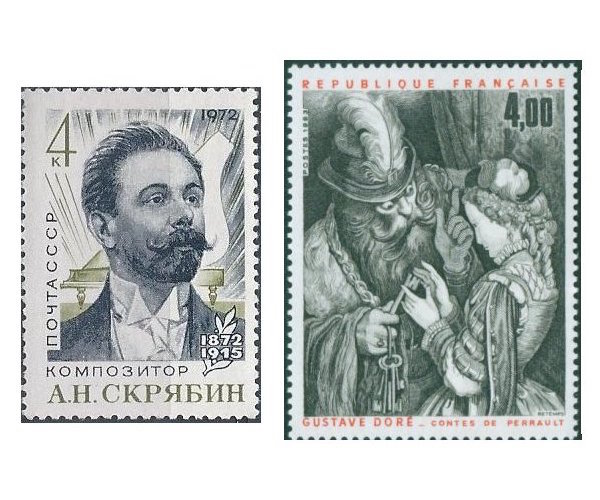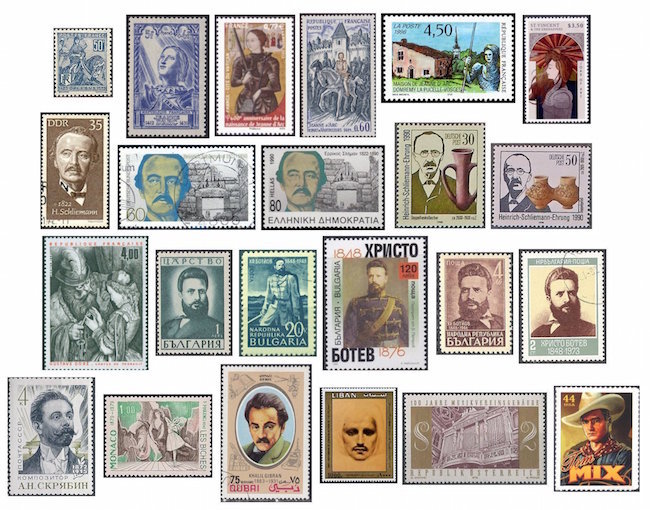The Arts on the Stamps of the World — January 6
An Arts Fuse regular feature: the arts on stamps of the world.

By Doug Briscoe
January 6 is the birthday of Scriabin and Doré, as well as Khalil Gibran, Bulgarian national poet Hristo Botev, and silent screen cowboy Tom Mix. We also salute Joan of Arc and Heinrich Schliemann, neither of them artists, of course, but both important in the world of art. Also, Vienna’s Musikverein was opened on this date in 1870, and Poulenc’s ballet Les biches was premiered on 6 January 1924.
It seems we know that Joan of Arc (Jeanne d’Arc) was born on this date, but we’re not certain of the year—1412, perhaps. Anyway, “The Maid of Orléans” has inspired any number of works of literature, music, film, and the visual arts (including stamps!), and as such, I thought we’d pay tribute to her here. I “limit” myself to five (!) of the Joan of Arc stamps issued by her beloved France and one from St. Vincent. Accused of witchcraft, Joan was burned at the stake on 30 May 1431.
German archaeologist Heinrich Schliemann (1822 – 26 December 1890) merits a mention, I think, as an important figure in (literally) unearthing great art of the Classical world and contributing to our recognition of the historical basis of the Iliad and the Aeneid. In the 1870s and 80s Schliemann excavated Hissarlik, now thought to be the location of ancient Troy, as well as Mycenae and Tiryns. His work has been much criticized for its recklessness and for the inaccuracy of some of his conclusions; yet as a pioneer in the field he has been honored on stamps from both Germany and Greece. These countries released a joint stamp issue in 1990 using the same basic design, a practice not at all uncommon in the world of philately.
Gustave Doré (1832 – 23 January 1883) is perhaps most familiar to us as a book illustrator rather than as an artist and sculptor. When he was just fifteen Doré drew caricatures for the French periodical Le Journal pour rire. Soon he began winning commissions to illustrate scenes from great literature with his wood engravings. The works of Dante, Rabelais, Balzac, Milton, Byron, and Poe, along with Coleridge’s Rime of the Ancient Mariner and Tennyson’s Idylls of the King, were graced with his art. Like so very many French luminaries, he is buried in Père Lachaise Cemetery. The one Doré stamp I could locate, oddly enough, depicts one of his illustrations for an edition of the folk tales of Charles Perrault, whose birthday is coming up in six days.
Hristo Botev (6 January 1848 [O.S. 25 December 1847] – 1 June [O.S. 20 May] 1876) is Bulgaria’s national poet. Born Hristo Botyov Petkov, he became a revolutionary, echoing the sentiments of his people in his poetry and taking up arms against the Ottoman occupation. He gave his life in that struggle, falling to a bullet from an Ottoman sharpshooter. Naturally Bulgaria has issued a slew of stamps in his honor, from which I have selected five.
Alexander Scriabin’s instrument was the piano. His birth date is 6 January 1872 in the Gregorian calendar, 25 December 1871 in the Julian. Scriabin’s earlier works were modelled on Chopin, but in his later ones he developed a highly individual and personal language. Apart from his symphonies and a handful of other pieces, all his music is for the keyboard. Scriabin was a synesthete (he saw specific colors associated with certain musical tones) and a mystic who at his death left unfinished a massive composition the first part of which was to be called “Universe” and which would have required the building of a cathedral at the foot of the Himalayas for its performance involving dance, lights, mists, incense, and a kitchen sink. The event would be followed by the end of the world. This project had been conceived (without the kitchen sink) as early as 1903, in which year Scriabin departed his native Russia, living in Switzerland, Paris, and Brussels before returning to his homeland in 1909. During these years of peregrination he visited the United States. While in Paris he worked with Serge Diaghilev. He died of septicemia (from a sore on his upper lip), aged 43, on 27 April (O.S. 14 April) 1915.

It was Diaghilev, coincidentally, who commissioned Francis Poulenc’s ballet Les biches, which had its première with the Ballets Russes 93 years ago today. (In an even more remarkable coincidence, Poulenc’s birthday is tomorrow! We’ll see his portrait stamp then.) The choreography was by Bronislava Nijinska, and the conductor was André Messager (whose stamp I posted exactly one week ago today). The title is usually given in French to avoid (or to encourage) the smirks, but when rendered in English it becomes The Girls or The Does or something that is not linguistically problematic. It derives, the title does, from French slang of the 1920s and refers to the coquettish young females who are the protagonists of this half-hour long ballet set at a house party. The stamp comes from a set commemorating the centenary of the Salle Garnier in Monte-Carlo (not to be confused with the Palais Garnier in Paris, which we saw here just yesterday).
Kahlil Gibran (1883 – April 10, 1931) was born in Lebanon, then part of the Ottoman Empire, but came to the U.S. with his family as a young man, settling in Boston’s South End. In his teens he was schooled in Beirut, but it was back in Boston, after art studies in Paris, that he presented his first exhibition of drawings in 1904. His famous philosophical book of prose poems The Prophet has sold millions of copies in forty languages since its appearance in 1923.
Vienna’s Musikverein building, the model for Boston’s Symphony Hall, opened its doors 146 years ago today. It was designed by Danish architect Theophil Hansen.
Tom Mix (b. 1880) was an iconic film star in early American Westerns. His appearances in nearly 300 films between 1909 and 1935 were almost exclusively in the silents, with just nine exceptions. One of the first movie superstars, he served as a model for all subsequent cowboy actors. Tom Mix was killed in auto accident on October 12, 1940.
A graduate of the University of Massachusetts with a B.A. in English, Doug Briscoe worked in Boston classical music radio, at WCRB, WGBH, and WBUR, for about 25 years, beginning in 1977. He has the curious distinction of having succeeded Robert J. Lurtsema twice, first as host of WGBH’s weekday morning classical music program in 1993, then as host of the weekend program when Robert J.’s health failed in 2000. Doug also wrote liner notes for several of the late Gunther Schuller’s GM Recordings releases as well as program notes for the Boston Classical Orchestra. For the past few years he’s been posting a Facebook “blog” of classical music on stamps of the world, which has now been expanded to encompass all the arts for The Arts Fuse.

Doug Briscoe, mentioned The Arts Fuse site to me and, what a treat! I have enjoyed my first visit and look forward to catching up with the Archives. I follow Doug on Facebook, however, The Arts Fuse is such a pleasant and easier read.
Ellen,
Thanks for reading the Arts Fuse. By all means check out the archives — and follow the reviews, features, interviews on the magazine. There is a lot more to come! Thanks again, and please tell others about us — an independent online magazine dedicated to serious coverage of the arts.